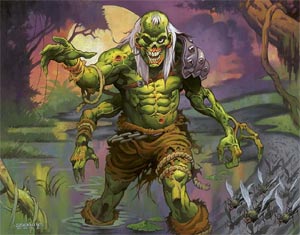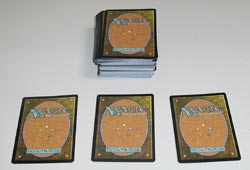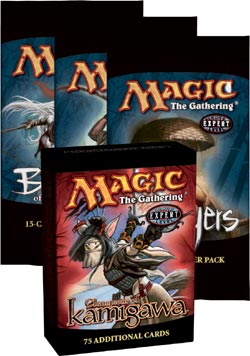Winston Draft
 Last week, Scott had to rerun one of my old articles because I was incapacitated. As late as Tuesday evening I believed, as the disclaimer on the article stated, that I had the flu.
Last week, Scott had to rerun one of my old articles because I was incapacitated. As late as Tuesday evening I believed, as the disclaimer on the article stated, that I had the flu.
I wish.
I got home from my trip to Pro Tour—Atlanta last Monday evening feeling just fine. I did all the normal stuff one does upon returning from a trip—play with child, chat with wife, call parents, halfway unpack, get a shower. As I was drying off after said shower, I was hit with a wave of the chills. It was pretty scary, actually—my muscles we tensing all over and I felt very, very cold and very, very weak. My teeth were chattering and I was gasping for breath. My wife got me into bed and covered me up, and I managed to sleep through most of the night.
Tuesday morning I woke up feeling like death and called off work. My left leg was hurting pretty badly and starting to swell a little. I had severely injured that leg as a child and I figured it was just acting up as it was prone to do; perhaps I aggravated something making the mad dash from terminal to terminal at O'Hare airport the day before. Or maybe the flu was doing something weird to it. Either way, my main goal was to kick the flu, so I spent all day taking Comtrex and drinking nasty TheraFlu.
Wednesday I woke up feeling pretty good—all the flu symptoms were gone. But my leg and foot were huge and red and I could barely walk on them. I showed them to my wife, and hinted that I was interested in scheduling a doctor's appointment. She took one look at it and told me we were headed to the emergency room.
To make a long story short, that trip to the emergency room kept me in the hospital for the better part of four days (Thank God for the NCAA Tournament!). I was tested for blood clots, diabetes, and heart problems, but it turned put to be a tissue infection—cellulitis—that got to be as bad as it did in part because of lingering damage from that childhood injury. You'd think that after 24 years with no serious side effects that you could put something like that behind you. Not so.
Anyway, after lots of rest and some ridiculous amount of antibiotics, I finally came back to work on Tuesday sporting a whole new limp and pockets full of pills. Quite the week! Why am I telling you all this? Am I looking for sympathy? No… I consider it free material. It isn't easy coming up with several thousand words each week!
Draft Dodging
Last week was Draft Week here on the site, and I missed it, which is a shame because I actually had a decent topic lined up. Lucky for me this is an open week, so I'm free to talk about whatever I want, including last week's topic.
The main thrust of my Draft Week article was not going to be about how development approaches draft—the nature of draft allows us to not focus a lot of attention on it, so there would barely be enough information to fill a whole article. Instead I want to talk about a cool new draft format that I learned around the office that was invented by the man himself, Richard Garfield.
But first, a few points on R&D and draft…
The Developer's Take
- Draft's “self-correcting nature” means that we don't need to do much to make sure the environment is balanced. If a color is by nature better than the others (as black was in Urza's Saga), then more players at the table will draft it, evening out the power level between decks, and allowing skill to be the determining factor for success. Instead, we tend to play sealed deck more in development, where color balance issues are more noticeable and have a bigger impact.
- We do test draft near the end of development to look for strategies that aren't evident in sealed play (think “Zubera deck”) and force those strategies to see if they are disproportionately powerful.
- Organized Play has recently announced that it will no longer be supporting individual Rochester draft as a format at PTQs, Pro Tours, and other high-level events. People hardly ever play the format for fun (it is slow and unforgiving—all your mistakes are laid bare for the table to see), and at higher levels it becomes very predictable. With card evaluation skills at an all-time high (thanks to the internet and Magic Online), it's easy to predict which cards will be taken where—there just aren't that many decisions when all the information is in front of you. So we'll be sticking to the tried-and-true Booster Draft format for the foreseeable future.
Winston Draft
 Magic is such a great game because it is so quick and portable. Any two players can sit down with decks and fight it out. Constructed works well with only two people, sealed deck works reasonably well with only two people, but draft just isn't the same without a full table.
Magic is such a great game because it is so quick and portable. Any two players can sit down with decks and fight it out. Constructed works well with only two people, sealed deck works reasonably well with only two people, but draft just isn't the same without a full table.
If you have ever tried any of the numerous one-on-one draft formats around (Booster, Solomon, Rochester), you'll quickly realize that the drafting experience is very different than drafting with four or eight people. The goal of one-on-one drafts isn't to get the best deck by normal means, but rather to memorize your opponent's picks and use that information to hate-draft him and sabotage his mana base.
I have never enjoyed playing that way, and have always been looking for what would be a slightly more random and fun one-on-one draft format. VP of R&D Bill Rose was kind enough to show me one.
“Winston Draft,” as it is called, was created by Richard Garfield. Richard was, like I was, looking for a one-on-one format with a little more luck in it. Here are the rules he set forth:
- Each player supplies 45 cards worth of sealed product (either three booster packs or a tournament pack minus the lands).
- Shuffle all 90 cards together in one big deck without looking at them.
- Choose someone to draft first, then put the top three cards from the deck face down next to it as three new small piles of one card each.
- The first player looks at the first small pile. He may choose to draft that pile or not.
- If he drafts it, he replaces that pile with a new face-down card from the deck.
- If he doesn't draft it, he puts it back, adds a new card from the deck face down, and moves on to the next pile.
- He looks at that pile and decides to draft it or not, replacing it with a new card if he drafts it, adding a new card to it and moving on if he doesn't.
- If he doesn't want to draft the third pile, he adds a card to it, then drafts a random card from the top of the deck.
- Continue until all 90 cards have been drafted. Construct 40-card decks and play.
The beauty of this format is that you only know about half of what your opponent has. You can still deduce his colors (generally) by looking at what he's leaving you, and with that information you can leave some cards on the table longer, adding more cards to the piles.
I find this format immensely enjoyable. My brother Neil and I burned through two boxes of booster packs over this past holiday season repeatedly Winston drafting. It even works well once you've opened all the packs… just select 90 cards at random, shuffle and go.
Sample Draft
 Here's an example of a Winston Draft between myself and my brother Neil. We started with the contents of one Champions of Kamigawa tournament pack (minus the basic lands) and three Betrayers of Kamigawa booster packs. That makes exactly 90 cards—perfect!
Here's an example of a Winston Draft between myself and my brother Neil. We started with the contents of one Champions of Kamigawa tournament pack (minus the basic lands) and three Betrayers of Kamigawa booster packs. That makes exactly 90 cards—perfect!
I win the coin flip and get to draft first. Neil shuffles the 90 cards and places the first three face-down near the deck as the three piles.
I look at pile number one—Thoughtbind. Not a great card; I expect to do better. I choose not to take it, put it back face down, then put another card from the deck on top of it. I then look at pile number two—Sakura-Tribe Elder. It's hard to say no to that little fellow, so he becomes my first drafted card (which I keep face down in front of me in a pile that I can peruse at any time). I then put a face-down card from the deck where pile number two was, and now it's Neil's turn.
He looks at the first pile, which is now two cards big—one Thoughtbind and one card I don't know. He doesn't want it, and adds a third card to it. He doesn't want the second pile, either, and adds a card to it. He does want whatever the third card is, however, so he takes it and replaces it with another face-down card. My turn.
The first pile is now three cards—a Thoughtbind that we both know about, a Guardian of Solitude that we have also both seen by now, and a Terashi's Grasp that Neil hasn't seen yet. I still don't really like this pile, so I add a fourth card and move on. Pile number two is a Reach Through Mists and a Serpent Skin. No thanks, I'm looking for creatures and removal primarily, so I add a third card to it and move on.
The third pile is a lone Genju of the Falls. Not bad at all. I think for a while and then decide to take it, hoping to later nab some of those blue filler cards that we've been leaving on the table. I put a new card face down in the pile number three slot.
Now I've got one good green card and one good blue card. Because neither of them are super-amazing bombs, I'd be willing to abandon either of them.
The draft progresses, and I eventually take pile one once it hits eight cards (Thoughtbind, Guardian of Solitude, Terashi's Grasp, Aura Barbs, Shell of the Last Kappa, Body of Jukai, Hearth Kami, and Wear Away). Neil is the first of us to forgo the three piles and draft randomly off the top. A few picks later I get a lucky Earthshaker (paired with a Devouring Rage), so I definitely plan to be red. A few rounds later I go off the top and am rewarded with a Rend Flesh (which, along with a Nezumi Graverobber, has me looking at black). Back-to-back Okiba-Gang Shinobi and an Ink-Eyes put me into black for good.
Here's my deck:
There's not a lot of synergy there with the Earthshaker, and the removal is pretty scant. But that's what I have to work with, and with a shallow card pool I can't really expect more. Now to play…
Last Week's Poll (March 11):
| What color do you foresee as the most powerful in post-Affinity Standard? | ||
| Green | 2861 | 26.9% |
| Black | 2780 | 26.1% |
| Red | 2122 | 19.9% |
| Blue | 1893 | 17.8% |
| White | 994 | 9.3% |
| Total | 10650 | 100.0% |

